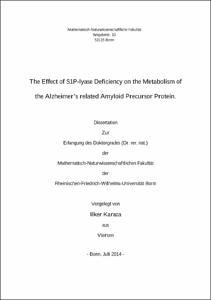Karaca, Ilker: The Effect of S1P-lyase Deficiency on the Metabolism of the Alzheimer’s related Amyloid Precursor Protein. - Bonn, 2014. - Dissertation, Rheinische Friedrich-Wilhelms-Universität Bonn.
Online-Ausgabe in bonndoc: https://nbn-resolving.org/urn:nbn:de:hbz:5n-38242
Online-Ausgabe in bonndoc: https://nbn-resolving.org/urn:nbn:de:hbz:5n-38242
@phdthesis{handle:20.500.11811/6199,
urn: https://nbn-resolving.org/urn:nbn:de:hbz:5n-38242,
author = {{Ilker Karaca}},
title = {The Effect of S1P-lyase Deficiency on the Metabolism of the Alzheimer’s related Amyloid Precursor Protein},
school = {Rheinische Friedrich-Wilhelms-Universität Bonn},
year = 2014,
month = dec,
note = {Alzheimer’s disease is neuropathologically characterized by intracellularly accumulated tau protein and by extracellular plaques, mainly composed of the small hydrophobic peptide amyloid β (Aβ). Sequential cleavage of the amyloid precursor protein (APP) by the transmembrane enzymes β- and γ-secretase generates Aβ. In addition to the proteolytic processing, APP can further undergo metabolic processing by acidic hydrolases in lysosomal compartments.
Membrane lipid composition is of great importance for the proper function of secretases, as well as for lysosomal activity. Disturbances in the lipid homeostasis can cause severe accumulations of different lipids and thereby also impair the metabolism of APP. Several lysosomal lipid storage disorders (LSDs) show pathological accumulation of lipids and share similarities to the pathological features of AD.
Here it is shown that accumulation of intracellular sphingosine-1-phosphate (S1P) impairs the metabolism of APP. Lack of the S1P cleaving enzyme S1P-lyase induces a LSD-like phenotype and causes an accumulation of full-length APP and its potentially pathogenic C-terminal fragments (CTFs) which was partially rescued by the inhibition of sphingosine phosphorylation. Genetic deletion of S1P-lyase impairs the β- and γ-secretase dependent processing of APP on one hand, but also decreased the lysosomal degradation of APP and its CTFs on the other hand. The increase of lysosomal marker proteins like cathepsin D or lamp2 indicated a general impairment of the lysosomal activity. Accumulation of APP and CTFs was also partially reversed when Ca2+ was selectively mobilized from endoplasmic reticulum or lysosomes. Additional results further indicate an involvement of protein kinase C in the altered lysosomal metabolism upon inhibition of S1P lyase.
Taken together, the data demonstrate that S1P-lyase plays a critical role in the regulation of lysosomal activity and the processing of APP. S1P and other sphingolipid metabolizing enzymes could therefore be further explored to dissect molecular pathways underlying the pathogenesis of AD and represent potential targets in disease progression or prevention.},
url = {https://hdl.handle.net/20.500.11811/6199}
}
urn: https://nbn-resolving.org/urn:nbn:de:hbz:5n-38242,
author = {{Ilker Karaca}},
title = {The Effect of S1P-lyase Deficiency on the Metabolism of the Alzheimer’s related Amyloid Precursor Protein},
school = {Rheinische Friedrich-Wilhelms-Universität Bonn},
year = 2014,
month = dec,
note = {Alzheimer’s disease is neuropathologically characterized by intracellularly accumulated tau protein and by extracellular plaques, mainly composed of the small hydrophobic peptide amyloid β (Aβ). Sequential cleavage of the amyloid precursor protein (APP) by the transmembrane enzymes β- and γ-secretase generates Aβ. In addition to the proteolytic processing, APP can further undergo metabolic processing by acidic hydrolases in lysosomal compartments.
Membrane lipid composition is of great importance for the proper function of secretases, as well as for lysosomal activity. Disturbances in the lipid homeostasis can cause severe accumulations of different lipids and thereby also impair the metabolism of APP. Several lysosomal lipid storage disorders (LSDs) show pathological accumulation of lipids and share similarities to the pathological features of AD.
Here it is shown that accumulation of intracellular sphingosine-1-phosphate (S1P) impairs the metabolism of APP. Lack of the S1P cleaving enzyme S1P-lyase induces a LSD-like phenotype and causes an accumulation of full-length APP and its potentially pathogenic C-terminal fragments (CTFs) which was partially rescued by the inhibition of sphingosine phosphorylation. Genetic deletion of S1P-lyase impairs the β- and γ-secretase dependent processing of APP on one hand, but also decreased the lysosomal degradation of APP and its CTFs on the other hand. The increase of lysosomal marker proteins like cathepsin D or lamp2 indicated a general impairment of the lysosomal activity. Accumulation of APP and CTFs was also partially reversed when Ca2+ was selectively mobilized from endoplasmic reticulum or lysosomes. Additional results further indicate an involvement of protein kinase C in the altered lysosomal metabolism upon inhibition of S1P lyase.
Taken together, the data demonstrate that S1P-lyase plays a critical role in the regulation of lysosomal activity and the processing of APP. S1P and other sphingolipid metabolizing enzymes could therefore be further explored to dissect molecular pathways underlying the pathogenesis of AD and represent potential targets in disease progression or prevention.},
url = {https://hdl.handle.net/20.500.11811/6199}
}






